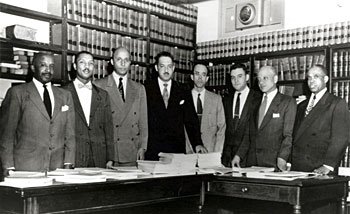
The NAACP Legal Defense team responsible for litigation leading to the Supreme Court's decision in Brown vs Board
| 1879 | The Kansas legislature allows Kansas cities with populations greater than 15,000 to segregate elementary schools. |
| 1896 | The Supreme Court, in Plessy v Ferguson, upholds a Louisiana law segregating railroad cars under the principle "separate but equal." |
| 1903 | William Reynolds, a black man, attempts to enroll his son in a white-only Topeka school. When his attempt fails, he takes his challenge to the Kansas Supreme Court, which upholds the policy of segregation, citing the Plessy decision. |
| 1942 | Dr. Kenneth McFarland, a strong supporter of segregation in schools, becomes the new superintendent of the Topeka school system. |
| 1948 | Esther Brown, a white woman from Merriam, Kansas, asks the Kansas NAACP branch to mount a legal challenge to segregated schools. In response, the NAACP branch presents a petition to the Topeka Board of Education on behalf of "The Citizen's Committee" asking it to end its policy of segregation. The petition meets stiff opposition and goes nowhere. |
| August 25, 1950 | Lucinda Todd, Secretary of Kansas's NAACP branch, writes to Walter White, head of the NAACP, indicating that the Kansas branch was prepared to take its challenge to the Topeka Board of Education's policy of segregation to federal district court. |
| February 28, 1951 | The case of Brown (named after Oliver Brown, father of nine-year-old Linda Brown) vs Board of Education is filed in the federal district court for Kansas. |
| June 25, 1951 | Trial day in Brown v Board of Education. Witnesses testify as to the harm caused by the policy of segregation. |
| August 3, 1951 | Judge Huxman, writing for a three-judge panel, issues his decision and findings in the Brown case. Judge Huxman upholds the Topeka Board's policy on the basis of Plessy, but his nine findings of fact indicate that the policy is harmful to the education of Topeka's black children. The NAACP announces it will appeal the decision to the United States Supreme Court. |
| October 16, 1951 | John W. Davis, one of the most prominent appellate advocates in the nation, agrees to defend segregated schools in the Supreme Court. |
| November 1951 | The NAACP Legal Defense Fund files an appeal of the Brown decision in the United States Supreme Court. In the weeks that follow, appeals in other cases around the country challenging segregated schools are also filed in the Court. |
| June 9, 1952 | The Supreme Court noes probable jurisdiction in Brown and schedules the case down for oral argument in October. |
| October 8, 1952 | Just three days before scheduled argument in Brown, the Court reschedules argument for December, and announces the Brown case will be combined with cases from South Carolina, Virginia, and Washington D.C. (In November, the Court added an additional case from Delaware.) |
| December 9-11, 1952 | The Supreme Court hears oral arguments in Brown and the other consolidated cases alleging that the policy of segregated schools violates the Constitution. In the Court's packed chambers, Robert Carter argued that the Topeka policy denied Brown the equal protection of the laws. Paul E. Wilson, assistant attorney general for Kansas, defended the Topeka policy. Later, other lawyers, including Thurgood Marshall for the NAACP and John W. Davis for the State of Virginia, would take their turns at the podium as the challenges from the other consolidated cases were argued. Davis predicts he has the case won, "five to four--or maybe six to three." |
| December 13, 1952 | The Supreme Court meets in conference to discuss the school segregation cases. Initial votes in the cases show four clear votes for ending segregation in all cases, and up to four for upholding the policy of segregation, and one justice (Felix Frankfurter) willing to strike down segregation in Washington D.C., but uphold it in the other cases. |
| June 8, 1953 | The Supreme Court orders all five cases to be reargued in the 1953-54 Term. |
| September 8, 1953 | Chief Justice Fred Vinson, one of the four justices who voted to uphold segregation, dies of a heart attack. President Eisenhower soon appoints Earl Warren to take Vinson's place. |
| December 8, 1953 | The school desegregation cases are reargued. |
| December 12, 1953 | After the second round of arguments, the Supreme Court meets in conference to discuss the school desegregation cases. This time, there are five clear votes for striking down policies of segregation. Several justices (especially Justice Stanley Reed) disagree, but are persuaded not to write dissents. |
| May 17, 1954 | A unanimous Supreme Court issues its decision in Brown v Board of Education of Topeka. The Court finds that segregation in the public schools is "inherently unequal" and violates the Fourteenth Amendment's Equal Protection Clause. |
| April 11-14, 1955 | The Supreme Court hears oral arguments concerning how its Brown decision should be implemented. |
| May 31, 1955 | In Brown II, the Supreme Court declares that desegregation of the public schools should proceed "with all deliberate speed." |
| January 1956 | All Topeka elementary schools are desegregated, with enrollment eligibility determined by attendance zones (except that students previously enrolled in a school outside of the new attendance zones are allowed to continue study at their schools). Unlike in some other cities, no significant demonstrations or violence accompanied the desegregation of the Topeka schools. |
| 1961 | Oliver Brown, serving as a minister at a church in Springfield, Missouri, dies of a heart attack. |
| October 26, 1992 | President H. W. Bush signs legislation establishing the Brown v Board of Education National Historic Site in Topeka. The site is operated by the National Park Service. |
